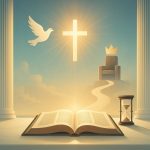| Host: | Alden Thompson |
|---|---|
| Guests: | Paul Dybdahl and Bruce Johanson |
| Quarter: | John: the Beloved Gospel |
| Lesson: | 7 |
| Sabbath: | February 14th, 2004 |
Relevant Passages John 6
The Sacred in the Common. John 6 links together three events in the life of Jesus: the feeding of he 5000, walking on water, and his “bread of life” sermon at Capernaum. The end result of these events was that “many of his disciples turned back and no longer went about with him” (John 6:66).
-
- The feeding of the 5000. The miracle of the loaves and fish is told in all four Gospels, the only one of Jesus’ miracles so honored. In John, however, several features are missing and several are added. In the synoptics, the feeding comes after Jesus attempts to get away from all the crowds. John doesn’t mention that “cause” at all. John adds the personal note that the five loaves and two fish were provided by a little boy’s lunch, a boy found by Andrew. And John follows up the miracle with the observation that the people wanted to take Jesus by force and make him king. Also in John, the feeding of the 5000 provides the background for Jesus’ sermon on the bread of life, a sermon which alienates many of his followers. What do these differences suggest as to the nature of the Gospel “parallels” and God’s concern that we get the historical details “just right”? Is there a parallel with the eagerness of the crowds to receive physical signs and physical nourishment from Christ when his real intent was to give them spiritual food?
- Ordinary food, the blending of the human and the divine. Note that Jesus did not meet all the people’s needs, nor did he provide them with a great banquet. He simply took a little boy’s lunch, five barley loaves and two fish, and multiplied them for the crowd. He also used very human means to distribute the food and to pick up the left overs. While Jesus on another occasion would feed 7000, these were clearly only occasional events and seemingly were triggered by compassion for the people’s basic needs. What does this story tell us about God’s intention to provide for all our needs? For us the question remains: Will there be, in our day, devout Christians who will starve to death while other Christians live in plenty?
- Deliverance at sea. John greatly abbreviates the story of the disciples’ sea-going venture. Matthew adds the account of Peter’s walking on the water; both Matthew and Mark significantly heighten the sense of panic among the disciples. The essentials are there in John, but without elaboration. Given John’s reference to the people’s eagerness to make Jesus’ king, what role does this miracle play in John’s narrative line? Is Jesus’ appearance simply an encouragement to his closest disciples, the ones who would stay with him to the end?
- Manna and Red Sea, food and deliverance. John seems to be echoing the great events of Israel’s history, the miraculous manna in the wilderness and the deliverance through the Red Sea. If, as Philip Yancey suggests in his book Disappointment with God, a time of many miracles in Scripture marks a spiritual low instead of a spiritual high, what might be the intent of drawing parallels with the events of the Exodus?
- Bread, body, blood – disenchantment. The largest part of John 6 narrates Jesus’ sermon on the bread of life and his “shocking” statement that those who truly follow Jesus must eat his flesh and drink his blood (John 6:53-58). How can one get past the gruesome physical aspects of this illustration and find the true spiritual meaning?
- The absent Lord. If one of the purposes of John’s Gospel is to meet the needs of second generation Christians who would never see Jesus in the flesh, does the “failure” of all the physical signs point to the truth which John really wants his readers to hear?





